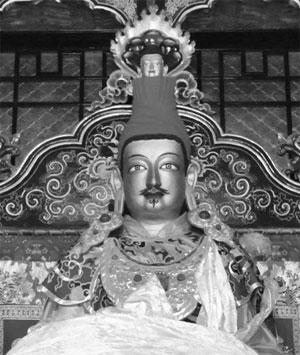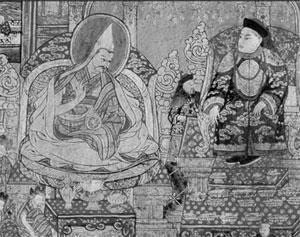Source:China Daily 2015-09-14
The Tubo Kingdom (AD 618-842)

Administrations of Tibet down the ages
In the early 7th century, Songtsan Gambo, the 33rd Tsenpo, or king, of the Tubo tribe, who was also the highest-ranked leader in Tibet, united more than 10 tribes to establish an empire called the Tubo Kingdom, also known as the Tibetan Empire, which had its capital where Lhasa now stands.
Songtsan Gambo enjoyed good relations with the Tang Dynasty (AD 618-907). His rule benefitted from technologies invented by Tang artisans, and he was influenced by Tang culture and politics.
In 641, Songtsan Gambo married Princess Wencheng, a member of the Tang royal family.
In 710, another Tang princess Jincheng, was sent from Chang'an, now Xi'an in Shaanxi province, to Tibet to marry the Tubo king, Tride Tsugtsen. In 821, Tubo sent envoys to Chang'an to form an alliance with the Tang court called the "Changqing Alliance" by historians.
The Tubo Kingdom fell apart in about 842 .
The Guge Kingdom in Western Tibet
Skyid-lde-nyima-mgon, a direct offspring of Songtsan Gambo, founded the three kingdoms in western Tibet, including the Guge Kingdom, in about 912. The kingdom was centered in present-day Zanda county, Ngari prefecture, the highest prefecture in the region. The kingdom employed calendars, medicine and astrology. The kingdom was conquered by the fifth Dalai Lama in about 1680, and the ruins are a must-see destination for visitors to Ngari.
The Yuan Dynasty (1271-1368)
Tibet formally came under the control of the Yuan Dynasty (1271-1368), and the Pagmo Gagyu sect, headed by Qamqoi Gyaincain, assumed power. Yuan rulers gave Qamqoi Gyaincain the title of Grand Minister of Education.
The Ming Dynasty (1368-1644)
In 1368, the head of any religious sect who could claim local political power was given an honorary title by the Ming court. Accession to the throne of the Tibetan Kingdom was subject to approval by the emperor, who dispatched officials to deliver a certificate acknowledging the title.
The Qing Dynasty (1644-1911)

Administrations of Tibet down the ages
In 1644, the Qing Dynasty overthrew the Ming Dynasty and tightened control over Tibet, bringing increased systemization and an expanded legal framework.
In 1652, the fifth Dalai Lama visited Beijing, then the Qing capital, at the invitation of the Emperor Shunzhi. In 1653, Shunzhi presented the Dalai Lama with a certificate of appointment made from gold leaf and a gold seal of authority, thus formally recognizing his status as the Dalai Lama.
In 1713, the Emperor Kangxi honored the fifth Panchen Lama, Lobsang Yeshe, by formally recognizing him as the Panchen Erdeni. Following this, the Dalai Lama in Lhasa ruled over the greater part of Tibet and the Panchen Lama, based in Xigaze, ruled the remainder. In 1727 the Qing court appointed a resident commissioner (called an Amban) as the government's representative in Tibet to oversee administrative affairs.
In 1793 the Qing government issued a 29-article ordinance dealing with the authority of the Amban, the reincarnations of the Dalai Lama, the Panchen Lama and other important Living Buddhas. The basic principles remained the standard for Tibet's administrative and legal systems for more than 100 years.
The Republic of China
In 1912, the Bureau for Mongolian and Tibetan Affairs was established by the government of the Republic of China to oversee and manage Tibetan affairs. The policy continued until the founding of the People's Republic of China in 1949.
The People's Republic of China
In 1951, representatives of the central government and the government of Tibet agreed to the peaceful liberation of Tibet.
In 1954, the 14th Dalai Lama was elected vice-chairman of the Standing Committee of the National People's Congress and the 10th Panchen Erdeni became a member of the NPC Standing Committee when the two monks attended the NPC's first session in Beijing.
In 1956, the Preparatory Committee for the Founding of the Tibet autonomous region was established and was presided over by the 14th Dalai Lama.
In March 1959, the Tibetan government launched a rebellion to separate the country and oppose reform. The central government quickly ordered the dissolution of the government.
In 1965, the Tibet autonomous region was founded.
Hu Yongqi
Source: The official website of the Chinese Embassy to Nepal
Copyright © Xizang Daily & China Xizang News All rights reserved
Reproduction in whole or in part without permissions prohibited
Index Code: 藏 ICP 备 05000021 号
Producer: Xizang Daily International Communication Center